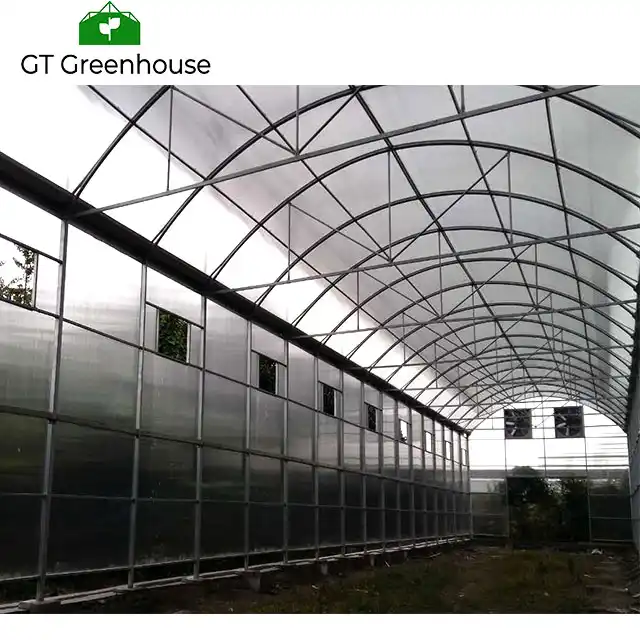Introduction:
Greenhouse structures have evolved significantly over time, offering a wide range of styles to meet the diverse needs of modern agriculture. These structures serve as integral components of controlled environments, providing optimal conditions for plant growth and maximizing crop productivity. In this article, we will explore the various styles of greenhouse structures, highlighting their distinctive features, advantages, and applications in today’s agricultural practices.
What are the main advantages of A-frame greenhouses compared to other styles?
A-frame greenhouses offer several advantages compared to other greenhouse styles, making them a popular choice for many growers. The main advantages of A-frame greenhouses include:
- Efficient Space Utilization: A-frame greenhouses make optimal use of vertical space. The sloping sides of the structure provide ample headroom for taller crops, allowing plants to grow vertically and maximizing the available growing area. This is particularly advantageous for crops like tomatoes, cucumbers, and vining plants that require vertical support.
- Good Air Circulation: The steep roof pitch of A-frame greenhouses promotes efficient air circulation. The upward slope facilitates the movement of warm air towards the ridge, while vents or sidewall openings can be strategically placed to allow for the release of hot air. This airflow helps regulate temperature, humidity, and prevents the buildup of stagnant air pockets, reducing the risk of fungal diseases and promoting plant health.
- Aesthetically Pleasing Design: A-frame greenhouses offer an attractive and symmetrical design that many growers find visually pleasing. The classic house-like shape adds a charming touch to gardens, nurseries, or small farms. This design feature can also appeal to customers at garden centers or farmers’ markets, enhancing the marketability of the produce grown inside.
Traditional Gable-Style Greenhouses
- Design and Features:
Gable-style greenhouses are characterized by their classic roof shape, which resembles an inverted “V” or “A.” These structures typically have high ceilings and steeply sloping roofs, allowing for efficient rainwater drainage and optimal light transmission. The gable design offers excellent air circulation and ample headroom for taller crops. - Advantages and Applications:
Traditional gable-style greenhouses are versatile and widely used in agriculture. Their spacious interiors and good ventilation make them suitable for a wide range of crops, including vine plants, tall flowers, and tomatoes. The high roof pitch facilitates snow shedding in colder climates, ensuring that the structure can withstand heavy snow loads.
Quonset-Style Greenhouses
- Design and Features:
Quonset-style greenhouses have a curved or semicircular shape, resembling a cylindrical half-tube. These structures are typically constructed with a series of arched hoops made of metal or PVC, covered with translucent plastic or greenhouse film. The curved design provides strength and rigidity to the structure. - Advantages and Applications:
Quonset-style greenhouses offer several advantages, including cost-effectiveness, ease of construction, and excellent space utilization. Their curved shape promotes efficient air circulation and reduces the occurrence of stagnant air pockets. Quonset-style greenhouses are often used for growing leafy greens, herbs, and smaller plants that do not require excessive vertical space.
Lean-To Greenhouses:
- Design and Features:
Lean-to greenhouses are structures attached to existing buildings or walls, utilizing the support and shelter provided by the pre-existing structure. They typically have a single sloping roof that is inclined towards the supporting structure, maximizing space utilization and minimizing material costs. - Advantages and Applications:
Lean-to greenhouses are popular in situations where space or budget constraints exist. They are ideal for homeowners, educational institutions, or small-scale farmers who want to incorporate greenhouse functionality into existing structures. Lean-to greenhouses are commonly used for cultivating small-scale vegetable gardens, starting seedlings, or growing ornamental plants.
A-Frame Greenhouses
- Design and Features:
A-frame greenhouses resemble the shape of a traditional house, with two sloping sides meeting at the ridge to form an “A.” These structures offer a symmetrical and aesthetically pleasing design. The steep roof pitch ensures efficient rainwater runoff and provides ample vertical growing space. - Advantages and Applications:
A-frame greenhouses are suitable for both small-scale and commercial operations. Their design allows for good air circulation and efficient use of space, making them ideal for growing a wide range of crops, including vegetables, flowers, and herbs. A-frame greenhouses are often favored by garden centers, nurseries, and hobbyist growers.
The diverse styles of greenhouse structures offer a range of options to suit the specific requirements of modern agriculture. From traditional gable-style greenhouses to cost-effective quonset-style structures, each style presents unique features and advantages. Whether it’s maximizing vertical space, greenhouse structure optimizing air circulation, or accommodating existing structures, there is a greenhouse style to meet the needs of various crops and growers. By harnessing the benefits of these different styles, farmers and gardeners can create controlled environments that promote optimal plant growth, increase productivity, and contribute to sustainable and efficient agricultural practices.
